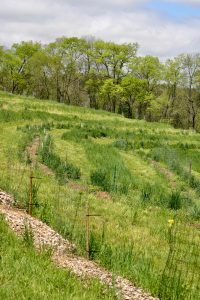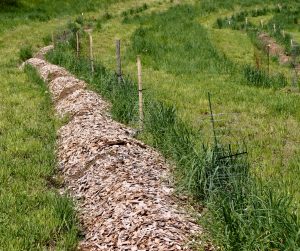 Our farmland is not flat everywhere. We have slopes, curves, and dips. Water and erosion control are always taken into consideration when adding planting areas on rolling grounds. By creating planting rows designed with our landscape in mind, we ensure that vegetation and trees will thrive and the land will not be negatively impacted.
Our farmland is not flat everywhere. We have slopes, curves, and dips. Water and erosion control are always taken into consideration when adding planting areas on rolling grounds. By creating planting rows designed with our landscape in mind, we ensure that vegetation and trees will thrive and the land will not be negatively impacted.
Ethan has planted many fruit and nut trees in the past few years. He’s busy again this year with additional trees and expanding the sloped planting rows. To maximize harvest production, vegetables are planted on the side of the rows and berry bushes between the trees. All of our planted berries (elderberries, currants, gooseberries, blackberries, and blueberries) will thrive as an under crop bush next to the trees. Garlic, tomatoes, potatoes, rhubarb, chives and much more are planted throughout the area.
So far, Ethan and Tim have been successful with water retention and avoiding soil erosion. In order to effectively plant in sloped areas, they’ll shoot grade or elevation by using a laser level and a story pole. This process allows them to follow contours along a slope, which will keep water on the plants. You’ll notice in my photographs that our rows are not perfectly straight. They might have a slight curve or two, and sometimes a curve going uphill.
 After the guys shoot the line, it’s marked with surveyor flags. Next, they add a slight swale to trap and hold water. This is accomplished by either running a rototiller over the planting line or using a one-bottom plow to create a slight furrow and turning the soil to the downhill side.
After the guys shoot the line, it’s marked with surveyor flags. Next, they add a slight swale to trap and hold water. This is accomplished by either running a rototiller over the planting line or using a one-bottom plow to create a slight furrow and turning the soil to the downhill side.
The plants are then placed in the ground on the downslope side of the swale, just beyond the banked up dirt. This allows water to remain in the swale and be absorbed by the roots of the plants. Some of our swales actually turn slightly uphill by a degree or two at the end of the row to allow water to be retained in the swale. This along with ground cover of perennial grasses stop erosion and retains soil moisture while providing maximum planting potential.
We’d like to hear about your experiences. Please comment with your questions or techniques that have worked for you.